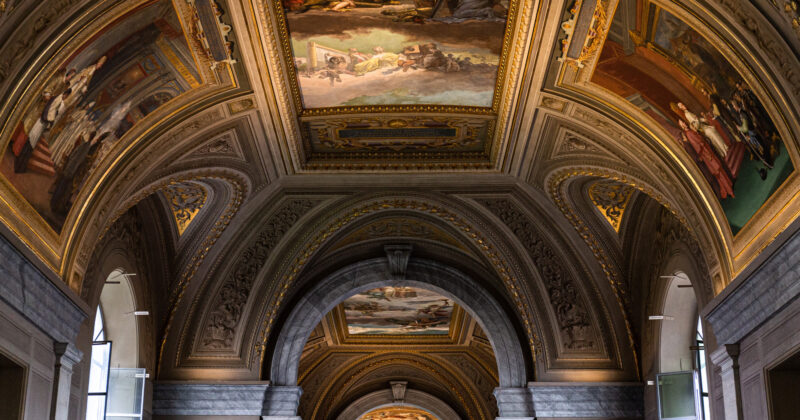Museums have long been the gateway to human history, art, and cultural understanding. In today’s digital world, museums reach an even broader audience by utilizing website platforms that highlight interactive exhibits, online collections, and educational resources. By transforming the way people learn and engage with exhibits, museum website design is an essential part of delivering a memorable visitor journey.
When it comes to growing your museum’s presence, it’s crucial to develop a web platform that both excites and informs potential visitors. Whether your museum specializes in fine art, science, or technology, your online domain has the potential to spark curiosity and drive in-person traffic. Our team has helped countless cultural institutions refine their digital approach. If you’re looking for guidance on developing or optimizing your museum’s online experience, don’t forget to explore our web services for fresh ideas and support.
Finally, a solid digital presence must revolve around user engagement. Museums thrive on educating the public, so harnessing interactive elements, virtual tours, and intuitive navigation can truly make your space stand out. From delivering enticing previews of upcoming exhibitions to providing easy access to tickets and membership details, a museum’s website can be the ultimate representation of creativity and innovation.
Examples of the Best Museum Website Designs
- The Metropolitan Museum of Art: The Metropolitan Museum of Art’s website invites visitors into a world of global art collections and cultural treasures. Its homepage features vibrant visuals and clear calls to action for current exhibitions and events. The user-friendly navigation allows art enthusiasts to explore various galleries, access educational resources, and plan their visit. Interactive features like virtual tours and high-resolution images let users get closer to artistic masterpieces than ever before. The site’s intuitive layout, bold typography, and striking photography blend together in a thoughtful way, making it one of the best museum websites for online exploration.
- Smithsonian National Museum of Natural History: Known for its diverse scientific collections, the Smithsonian National Museum of Natural History’s website showcases an impressive digital interface. From dinosaur bones to rare gems, the homepage instantly draws users into a realm of discovery. Site visitors can easily navigate through permanent exhibits, read up on scientific expeditions, and see upcoming educational programs. The carefully organized content sections highlight a consistent design language while the interactive elements keep users engaged. Overall, the site stands out for its strong focus on user experience, employing videos, high-quality images, and well-structured menus that foster curiosity and ongoing exploration.
- The Louvre: The Louvre’s website delivers a captivating digital journey through one of the world’s most famous museums. Its sophisticated design, available in multiple languages, features effortless navigation menus and prominent search tools to help visitors find artworks like the Mona Lisa. Virtual tours offer immersive 360-degree views of museum galleries, bringing centuries of art and history directly to the user. The color palette and layout mirror the museum’s iconic identity, blending modern web design with historical reverence. This website serves as an ideal resource for those planning a trip or simply exploring global masterpieces from home.
- The British Museum: Celebrating cultural heritage across millennia, The British Museum’s website presents a refined, minimalistic design that effectively highlights artifacts, exhibits, and collections. It guides users from an engaging homepage, featuring large banners and exhibit highlights, to carefully categorized collections that can be filtered by era, geography, and theme. Online visitors can read detailed object histories, watch educational videos, and even buy merchandise. With its high-contrast color scheme and focus on streamlined navigation, this site stands out among the best museum websites, offering both aesthetic appeal and top-tier functionality for a smooth museum web design experience.
- National Gallery of Art: The National Gallery of Art’s website offers art lovers an immersive online environment. Its clean layout highlights current exhibitions and cultural events, presenting them in beautiful banner slides and easily digestible text sections. A well-structured menu allows visitors to explore everything from curated exhibitions to educational resources and museum membership information. The robust “Art + Education” section integrates interactive activities for users of all ages, fostering an inclusive digital space. With high-resolution images, user-focused navigation, and a thoughtful brand identity, the National Gallery’s site exemplifies how museum website design can be artistic and practical.
- MoMA (The Museum of Modern Art): MoMA’s website combines bold design elements and straightforward navigation to engage its modern art audience. Large imagery at the top of each page invites users to view current exhibits and events, while clear calls to action promote memberships and ticket purchasing. The layout is uncluttered, allowing modern artwork to shine through without overwhelming the user. Interactive elements, such as the “Explore” section, present curated stories and multimedia experiences that bring featured pieces to life. By aligning crisp typography with contemporary visuals, MoMA’s website sets a high standard for museum web design and digital innovation.
- Guggenheim Museum: The Guggenheim’s website radiates the museum’s iconic architecture and contemporary art focus. Full-width images showcase landmark exhibits and the famous spiral layout of the museum itself. A simplified navigation menu drives users toward ticket purchasing, membership details, and the latest exhibits or programs. Hover-over effects and subtle animations give the user journey a sleek, modern feel. Educational resources are arranged neatly, while a thoughtful approach to blog content connects visitors to behind-the-scenes updates. The balance between dynamic visuals and minimalistic design cements the Guggenheim’s online platform as a model of forward-thinking museum website design.
- Van Gogh Museum: With its vibrant imagery and storytelling approach, the Van Gogh Museum’s website conveys the artist’s spirit from the moment users land on the homepage: clean typography and a bright, welcoming color palette echo Van Gogh’s colorful masterpieces. Visitors can explore the collections online, reading the inspiration and history behind each piece. The “Plan Your Visit” section features an easy-to-navigate calendar with upcoming events, while the shop integrates seamlessly. Interactive timelines and curated image galleries reinforce the educational aspect, making it one of the best museum websites for in-depth art appreciation and user engagement.
- National Museum of African American History and Culture: This museum’s website is a powerful celebration of African American history and culture, offering a compelling virtual experience. It uses a sleek, modern layout where exhibits and collections are presented with respect and depth. Bold visuals guide users through the museum’s various sections, from powerful historical narratives to contemporary cultural expressions. Educational programs, research tools, and online archives are readily accessible, allowing users of all backgrounds to explore. Rich images and a clear call-to-action for tickets, donations, and memberships help visitors stay informed and engaged. The design is inclusive, well-organized, and socially impactful for all audiences.
- The Science Museum: Celebrating scientific exploration, The Science Museum’s website welcomes visitors with futuristic designs and interactive content blocks. Users can easily navigate between current exhibitions, hands-on activities, and special events. The homepage highlights upcoming science festivals, while the streamlined menu covers all relevant sections, from “Visit Us” to “Learning.” Its balanced blend of text, images, and videos appeals to a broad audience, including families and educators. A user-friendly ticketing system and membership area further enhance the visitor journey. Overall, the site’s approach stands out for its creative animations, modern layout, and consistent branding that captures the excitement of discovery.
- The Field Museum: The website greets users with a dynamic homepage featuring bold photography of iconic exhibits like Sue the T. rex. The design cleverly weaves storytelling elements around scientific exploration, providing easy-to-digest information about research and education programs. A striking menu bar leads to exhibit details, a blog highlighting discoveries, and straightforward options to buy tickets or become a member. Vibrant colors bring life to the collection previews, while the streamlined navigation ensures visitors can quickly find what they’re looking for. The Field Museum exemplifies how museum web design can captivate online audiences by blending immersive visuals and interactive learning opportunities.
- Museo Reina Sofía: The website highlights modern and contemporary Spanish art within a clean, bilingual interface. Large, evocative visuals feature works by artists like Picasso and Dalí, while a responsive design ensures seamless viewing on any device. Users can easily delve into current and upcoming exhibitions, organized by category for simpler navigation. A robust “Collection” section provides detailed background on each piece, and the “Digital Experiences” feature fosters engagement through virtual tours and interactive content. With comprehensive visitor information and a coherent brand aesthetic, this platform offers an immersive experience that echoes the museum’s avant-garde spirit.
- Vatican Museums: The site offers a profound digital experience that captures centuries of art and ecclesiastical history. The homepage effectively showcases significant highlights like the Sistine Chapel, encouraging visitors to explore further. With easy-to-navigate panels for exhibitions, guided tours, and ticket options, users can plan an itinerary that suits their interests. High-resolution image galleries allow for up-close examination of intricate artworks and sculptures. Despite representing ancient treasures, the layout and design maintain a modern feel. Overall, the site bridges the old and new through an inviting interface, making it a must-see example of refined museum website design.
- Museum of Science and Industry, Chicago: This Chicago-based museum’s website immediately immerses users in interactive learning through stunning full-screen visuals and clear directions on how to explore exhibits. A straightforward main menu points visitors to feature attractions, ticket information, and membership benefits. The site effectively uses a consistent color scheme to reinforce brand identity and guide user engagement. Virtual exhibits and online educational activities extend the museum experience beyond physical walls, inviting families, students, and educators to learn online. Structured event listings and easy calendar functionality ensure that planning a visit is hassle-free. Its engaging design and interactive content positions it among the best museum websites.
- Rijksmuseum: The Rijksmuseum’s website mirrors the grandeur of its Dutch art and history collections with a clean, classic look. A prominent search bar supports quick access to specific artworks or exhibitions, appealing to scholars and casual enthusiasts. Featuring large, high-quality images, the site encourages users to engage with famous pieces like Rembrandt’s “The Night Watch” via detailed descriptions. Sections for families, schools, and researchers are neatly organized to cater to diverse audiences. The website’s integrated e-ticketing and membership features simplify the user journey. Its strong brand identity and user-centric navigation demonstrate how museum web design can be immersive yet straightforward.
- The Frida Kahlo Museum: Vibrant color palettes and rich photography evoke the spirit of Frida Kahlo’s art and life on this website. The homepage introduces visitors to La Casa Azul’s cultural significance while offering immediate access to ticket purchases and visitor information. Unique elements such as embedded videos and slideshows reflect the museum’s creative essence. Browsers can delve into Kahlo’s biography, personal items, and artwork for an immersive learning experience. Even for non-Spanish speakers, the bilingual site ensures accessibility. This platform exemplifies how museum websites can best leverage compelling visuals and storytelling to draw art aficionados into the artist’s world.
- Anne Frank: The website presents a significant experience that traces Anne Frank’s life and legacy. Immediately striking visitors with impactful photos, it sets a reflective tone that resonates with the museum’s purpose. Users can explore the Secret Annex in a virtual tour, learning about the historical context via videos, biographies, and timeline features. The minimalist color scheme and subtle design features highlight the museum’s solemn content, ensuring that the focus remains on the importance of remembrance. Clear calls-to-action for visiting, donating, and supporting are discreetly placed yet effective, making this an engaging, thoughtful museum website design.
- Natural History Museum, London: This website draws inspiration from the wonders of the natural world, greeting users with striking background images of wildlife and geological formations. A well-structured homepage highlights featured exhibits, news, and educational content. Easy navigation ensures quick access to tickets, membership details, and exhibition guidelines. The interactive “Explore” section allows curious learners to delve into scientific facts, research findings, and behind-the-scenes stories. High-quality visuals and thoughtful micro-interactions, such as hover effects, keep visitors enthralled. Balancing interactive media with a modern design, the Natural History Museum’s online presence captures the awe of its physical collections.
- Tate Modern: The website exemplifies contemporary design, beginning with bold statements about its current exhibitions. Large images and minimalist text blocks direct users to delve deeper into the collection or plan a visit. The user interface embraces a grid-like approach, structuring content under categories like exhibitions, events, and learning resources. Art lovers can browse the online collection, discovering modern works from various movements and cultures. The site also connects visitors to Tate’s social media for ongoing engagement. This cohesive strategy of visual storytelling and streamlined navigation demonstrates why Tate Modern’s platform stands out in museum web design.
- Musée d’Orsay: Renowned for its Impressionist masterpieces, the Musée d’Orsay offers an aesthetically refined website that resonates with the elegance of 19th-century art. Upon arrival, visitors are greeted by rotating banners showcasing current exhibitions and featured works by artists like Monet and Degas. The top navigation bar is neatly organized, leading to collections, ticketing, and educational programs sections. The site’s light color palette and subtle typography mirror the museum’s architectural beauty and artistic focus. With image galleries, guided tours, and engaging historical context, the Musée d’Orsay’s platform offers a tasteful blend of user-friendly functionality and cultural depth.
In the digital era, museums must adapt to an online presence that conveys their unique offerings while engaging diverse audiences. A well-designed website is crucial to building community, sharing knowledge, and inspiring visitors to enter the physical doors. By integrating high-quality visuals, interactive elements, and informative content, these institutions can seamlessly enrich our cultural journey, both online and offline.
Functionality and storytelling should go hand in hand when building a museum website. Combining straightforward navigation with captivating visuals sets the stage for compelling narratives about art, science, and history. By investing in continuous improvement—whether through updated virtual tours, online ticketing enhancements, or bilingual content—museums can keep their audience engaged for the long haul.
If you aspire to create the next leading platform in museum web design, remember to focus on accessibility, user-friendly navigation, and a cohesive brand identity. With a well-executed site, your museum can thrive in a competitive digital landscape, reaching new audiences and furthering its mission to educate and inspire.
Top 10 Most Important Aspects of a Museum Website
- Engaging Visuals: Use high-quality images and videos to showcase exhibits and artifacts, compelling visitors to explore further.
- User-Friendly Navigation: Employ clear menus and intuitive site structure, ensuring visitors can locate vital information like tickets and exhibition details without hassle.
- Mobile Responsiveness: Optimize layouts for phones and tablets so every visitor enjoys a seamless browsing experience, regardless of device.
- Accessibility Features: Include alt text, captions, and contrasting colors to accommodate all visitors, reflecting your museum’s commitment to inclusivity.
- Virtual Tours: Provide immersive, interactive elements that allow users to sample exhibits and engage with collections remotely.
- Educational Resources: Offer lesson plans, videos, and research tools that cater to students, teachers, and lifelong learners seeking more depth.
- Online Ticketing: Streamline the visiting process with straightforward purchasing and reservation options, promoting a hassle-free approach.
- Clear Calls-to-Action: Highlight important actions such as “Donate,” “Become a Member,” or “Buy Tickets” to guide user engagement and museum support.
- Brand Consistency: Reflect your museum’s identity through cohesive color palettes, typography, and messaging for a recognizable experience.
- Regular Updates: Keep event calendars, exhibition schedules, and blog content fresh to maintain visitor interest and build ongoing excitement.
Frequently Asked Questions About Museum Web Design
How can I make my museum website stand out from competitors?
A combination of high-resolution visuals, compelling storytelling, and user-oriented navigation can set your museum site apart. Focusing on unique branding and immersive features like virtual tours also helps spark interest among potential visitors.
What platform is best for building a museum website?
While there are numerous platforms available, WordPress often stands out due to its flexibility, user-friendliness, and extensive plugin options. These features support everything from event calendars to e-commerce, making it an excellent choice for museum websites.
How much does it typically cost to design a museum website?
Costs vary depending on the scale and complexity of the project, but a basic museum website can start around $2,000 and increase from there if you require features such as e-commerce ticketing, multimedia galleries, and interactive virtual tours.
How often should I update my museum website?
Regular updates are essential for keeping information accurate and engaging, but avoid changing content simply to appease search engines. Focus on updates that genuinely add value to your visitors by highlighting new exhibits, upcoming events, or research discoveries.
Why is a digital presence important for my museum?
A strong digital presence broadens your audience, reaching visitors who may not be able to visit physically. It also supports deeper engagement with online resources, fosters community interaction, and reflects your museum’s commitment to innovation and accessibility.
Ready to elevate your museum’s website? Contact CyberOptik for a free proposal for your new museum website design and set your business up for success.




